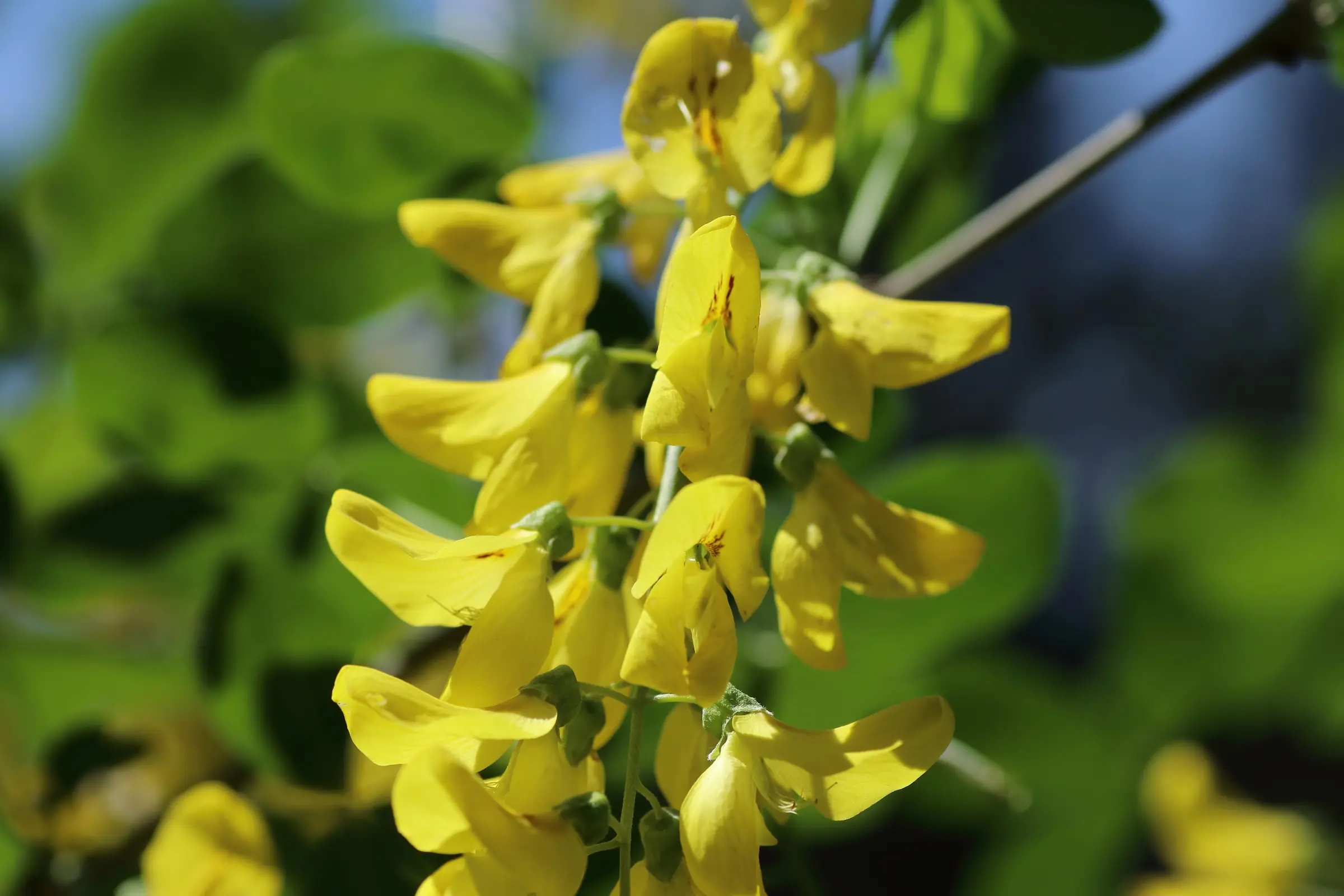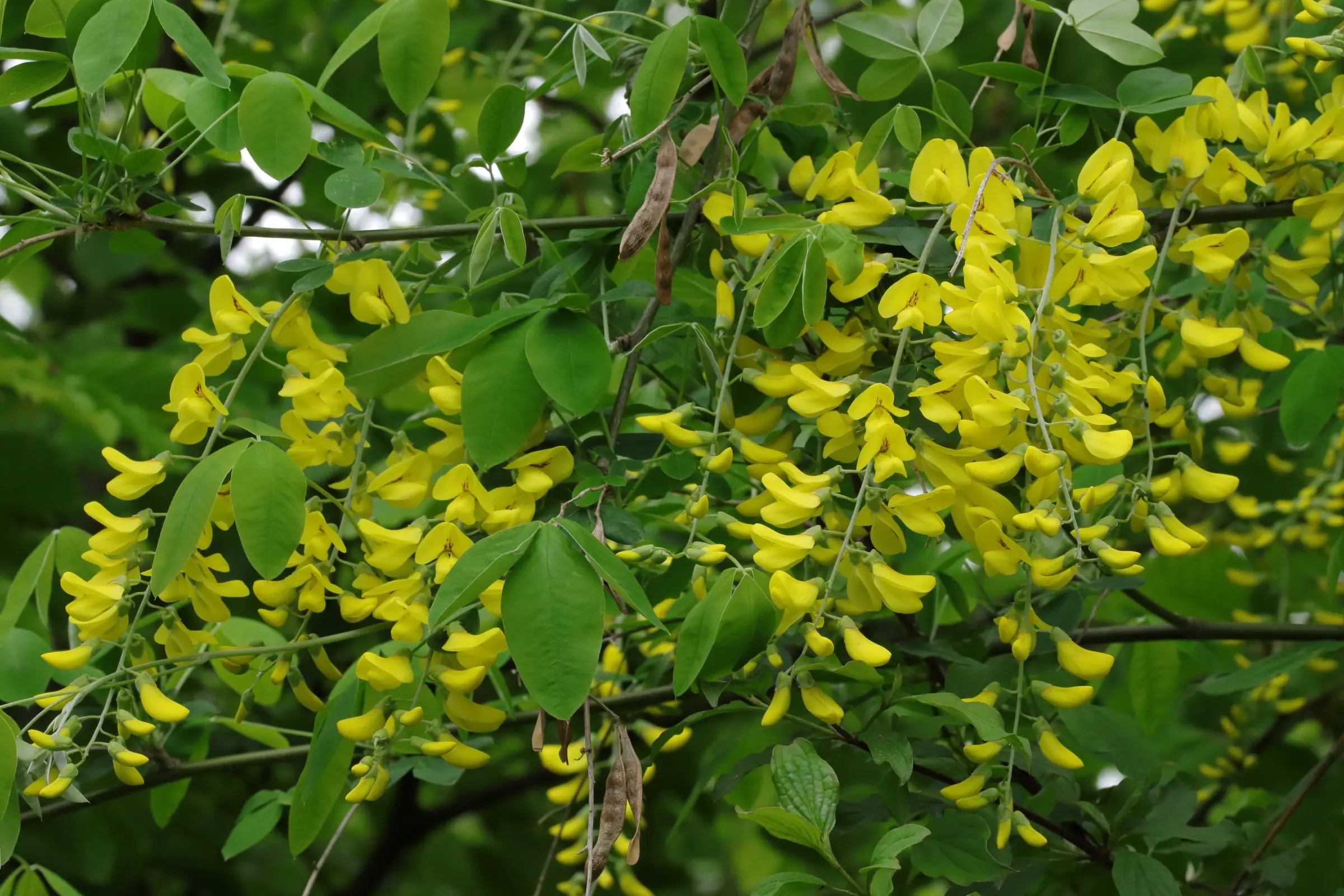~ german poisonous plant of the year 2012 ~
This southern european beauty is a member of the legume family (Fabaceae): the common laburnum. However, you should not be dazzled by the beauty of the blossoms as it is a highly poisonous plant in all parts!



Occurrence and distribution: The common laburnum is in most cases found in Central Europe as an ornamental plant. In some cases, it can also be found near humans as a “wild plant” (synanthropic). The plant originates from southern and south-eastern Europe and parts of western Asia. There it can be found in “wild chequer tree and downy oak forests” (Quercetalia pubescenti-petraeae communities 1) and in “manna ash-hop hornbeam forests” (Orno-Ostryetum communities 2). These are sub-Mediterranean to Mediterranean plant communities. It prefers a sunny, calcareous loamy soil. The second plant species in the genus is found in the Alps: the “Alpine laburnum” (Laburnum alpinum). It is a hardy plant, despite its origin in the Mediterranean region.
Plant description
Growth type: The laburnum is a deciduous shrub or small tree. The plant reaches a height of up to 7 metres. The branches form a layer of cork instead of bark. Hanging inflorescences also form at the ends. The plant can reach an age of between 20 and 30 years. The common laburnum is exclusively deciduous. In winter, only the woody parts of the plant remain. In spring and over the summer, light green coloured secondary shoots develop.
Leaves: The leaves are arranged in alternate pairs on the branches. Individual leaves are each tripinnate. The edge of the leaflets is smooth. The upper side of the leaves is dark green in colour. Leaflets are ovate to obovate / elliptical in shape. A small spine forms at the end of the leaflets. The midrib is clearly pronounced. The underside of the leaves is slightly grey due to the hairs.
Flowers: The common laburnum forms terminal, loose flower clusters at the end of the side shoots. These hang downwards away from the plant. The individual flower clusters consist of 18 to 45 yellow-coloured flowers. Flowers are zygomorphic and have a double perianth. The common laburnum flowers from May to June.
Fruits: The fruits consist of one to multi-seeded legumes. These are elongated and have dark brown to slightly grey hairs on the surface. The fruits ripen in August to September.


Detailed description of individual plant parts
Detailed description of the flowers: The upper fused petals (vane) are larger than the lower flower parts (boat) with the wings (flower parts protruding from the side of the boat). In total, the flower consists of five petals (so-called boat-shaped flowers). The ovary with the pistil (which is smooth) develops inside the boat (lower part of the flower). Around the pistil are the 10 stamens (these are usually fused together in pairs). The flowers are hermaphrodite inflorescences. The flowers are pollinated by various wild bees, flies and honey bees.
Detailed description of the seeds: As the seeds mature, the individual chambers of the seed pods thicken. The seed capsules burst open when fully ripe. This results in a sudden dispersion of the seeds over several metres. The burst seed capsules have a “corkscrew shape”. They are shiny on the inside. The individual seeds are black in colour and roundish.
Toxicity of the plant – handling tips
Toxicity of the plant 3: Common laburnum is a toxic plant that is poisonous in all parts! Special care must therefore be taken when handling the plant. Gloves should always be worn when cutting the plant. The green cuttings should not be used on your own compost heap, as the sap of the branches, twigs and leaves contains poisonous substances. These remain toxic even in the dried plant parts! The fruit pods with the seeds are among the most poisonous parts of the plant. The seeds should never be eaten! It should not be planted near nurseries or playgrounds as the plant is highly poisonous and children could come across the seeds, seed pods or flowers while playing.
Even chewing the seeds or sucking on the yellow-coloured flowers can lead to poisoning. The flowers have sometimes been used as a “substitute for robinia flowers for flavouring”! THIS SHOULD NOT BE DONE UNDER ANY CIRCUMSTANCES! 4
As Carsten Schleh aptly puts it in his book “Vorsicht da steckt Gift drin!” (“Beware there’s poison in it!”), children should be checked immediately on first suspicion of contact with a “pea plant” to see what they have found. It could well be the laburnum. In the event of poisoning, it is important to react quickly. A doctor should be consulted!
In the event of severe poisoning, the affected person must be taken to hospital immediately! If necessary, a doctor should also call the poison control centre.
Popular names
Popular names of laburnum: The plant is known by various popular names. These include “bean tree” – in reference to the shape of the plant’s fruits – “golden rush / yellow bush” – after the colour of the flowers. The name “clover tree” is derived from the shape of the leaves.
Origin of the genus and species name
Origin of the genus name 5: The genus name “Laburnum” is considered to be an anagram of the Latin word “alburnum”, meaning “white sapwood”. The genus “Laburnum” was first described in 1759 by the German physician and botanist Philipp Konrad Fabricius in his work Enumeratio Methodica Plantarum, p. 228 6 7.
Origin of the species name 8: The species name “anagyroides” can be translated into English as “stink tree-like”. This refers to the similarity to the stink shepherd’s tree (Anagyris foetida) – this shrub has three-part leaves and butterfly-shaped flowers.
Distribution codes: none – only cultivations! [A, AV, M1, M2, F, K (synthetic / synanthropic)]
The following section is not suitable for people with sensitive personalities. Please only read it if you are really interested. There is a lot of medical terminology and a description of the symptoms.
Breakdown of the ingredients
Ingredients 9: Chinolizidin-Alkaloid: Cytisin, N-Methylcytisin, Hydroxy-norcytisin; Pyrrolizidinalkaloidis: Laburnin, Laburnamin
Content of the ingredients 10: The alkaloid content in the following table refers to the “toxic substances contained in the individual parts of the plant as a percentage of the dry weight of the plant parts”. The alkaloids were also detected in the bark of the roots.
| Leaves | about 0.3 – 0.4 % |
| Blossoms | about 0.9 % |
| ripe seeds | over 2 % |
“Cytisine” is the main alkaloid found in the ripe seeds. In addition, the secondary alkaloid “N-methylcytisine” also occurs in smaller quantities. It is less toxic than the main alkaloid and is more frequently formed in the young shoots of the plant. The pericarp of the (immature) seeds also contains “hydroxy-norcytisine” 11. As the fruit ripens, the alkaloid content in the fruit rises sharply. This can be attributed to the fact that alkaloids can serve as a source of nitrogen for seed germination.
The cultivars (which are often sold commercially – Laburnum × watereri) contain other quinolizidine alkaloids such as epi-baptifolin and the dipiperidine alkaloid (ammodendrine) as the main alkaloid in the leaves.
Laburnum also contains a small amount of pyrrolizidine alkaloids such as “laburnin, laburnamine”. These are negligible given the acute toxicity of the other toxins.
LD50 for animals & humans
Lethal dose for poisoning of animals: The following LD values were determined for various animal species [Source: Institute of Veterinary Pharmacology and Toxicology / Clinitox 12]
| Horse: | 0.5 g seeds/kg body weight |
| Chicken/pigeon: | 6 g seeds/kg body weight |
| LD50 cat (s.c.): | 3 mg/kg seeds/kg body weight; Cytisin |
| LD50 dog (s.c.): | 4 mg/kg seeds/kg body weight; Cytisin |
| LD50 goat (s.c.): | 109 mg/kg seeds/kg body weight; Cytisin |
LD for humans: A critical dose for children is considered to be as low as three seeds. [Source: GIZ Nord]. According to Schneider Arzneidrogen and HagerROM, the lethal dose with the plant for adults is given as approx. 4 unripe fruits (entire pods incl. seeds) or 15 to 20 seeds or 10 flowers.
Poisoning with the plant
Symptoms of poisoning with common laburnum: In the case of poisoning with laburnum, symptoms occur after a short time (approx. 15 to 30 minutes, more rarely after 1 hour). These include severe (persistent) vomiting, abdominal pain, paleness, nausea, tremors and headaches. There is also a burning sensation in the throat and pharynx as well as thirst, dilated pupils (mydriasis) with visual disturbances, tachycardia and increased saliva production. Unconsciousness, somnolence, muscle weakness and gait instability have also been observed in some cases. Haemorrhage in the kidneys may occur. Hallucinations and convulsions also occur in severe cases of poisoning. Cyanosis (blue colouring of the skin, mucous membranes, lips and fingers) may also occur. In cases of severe poisoning, death occurs without medical treatment due to respiratory arrest.
It should be noted that in most cases the poisoning can have a milder course, as the toxins are less absorbed by the body due to vomiting. No deaths have been recorded in recent literature. Nevertheless, it is a poisonous plant and care should be taken when handling it.
Effect on grazing animals: Care must be taken to ensure that grazing animals (cows, sheep, goats) do not come into contact with the plant. According to Clinitox, cattle and goats are categorised as more resistant. The toxin “cytisine” is excreted in the milk. This can sometimes lead to poisoning from the milk, even if you have had no contact with the plant yourself.
First aid: If you suspect that you have been poisoned by the plant, seek medical treatment immediately! No measures can be taken on your own! Only symptomatic therapy and decontamination can be given to animals.
Mechanism of the toxins
Mechanism of the toxins: The toxins initially have a nicotine-like effect in humans. Initially, a general excitement is observed. Later, the function of the central and sympathetic nervous system is dampened. The toxin “cytisine” attacks the ACH receptors of the central nervous system in the ganglia and the neuromuscular end plate.
Severe intoxication can lead to a delirious state in the patient. This is often associated with tonic-clonic seizures. This results in a loss of consciousness, rigidity of the entire body, apnoea (respiratory depression) and increased salivation (depending on the duration, foam may form in front of the mouth). In the further stages, twitching of the arms and legs occurs. The more seeds ingested, the more pronounced the symptoms, as a greater amount of poison is released. In severe cases of poisoning, death can occur through respiratory arrest (due to paralysis of the respiratory muscles) and circulatory arrest.
- Quercetalia pubescenti-petraeae-Gesellschaften, Ökologie-Seite ↩︎
- Orno-Ostryetum-Gesellschaften, Ökologie-Seite ↩︎
- Clinitox Datenbank, Eintrag Goldregen ↩︎
- Furet, Y., D. Ernouf, J.F. Brechot, E. Au-tret e M. Breteau: Intoxication collective aux fleurs de cytise. Press. Medic. 15(23), 1103-1104 (1986). ↩︎
- Forstbotanik der Uni Freiburg ↩︎
- ENUMERATIO METHODICA PLANTARUM […] EDITIO SECUNDA bei der Real Jardín Botánico ↩︎
- GBIF-Eintrag ↩︎
- Forstbotanik der Uni Freiburg ↩︎
- Clinitox Datenbank, Eintrag Goldregen, Inhaltstoffe ↩︎
- Frohne – Pfänder in Giftpflanzen – Ein Handbuch für Apotheker, Ärzte, Toxikologen und Biologen, 5. Auflage ↩︎
- Alison R. Hayman, David O. Gray, Hydroxynorcytisine, a quinolizidone alkaloid from Laburnum anagyroides, Phytochemistry, Volume 28, Issue 2, 1989, Pages 673-675, https://doi.org/10.1016/0031-9422(89)80087-1. ↩︎
- Institut für Veterinärpharmakologie und ‑toxikologie – Clinitox Datenbank, Eintrag Goldregen ↩︎